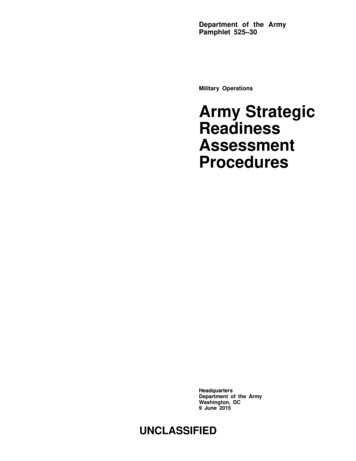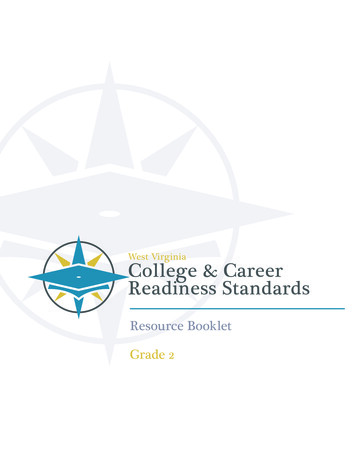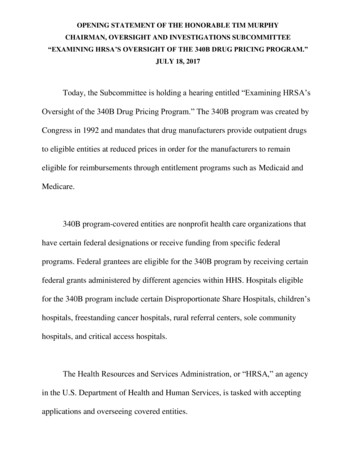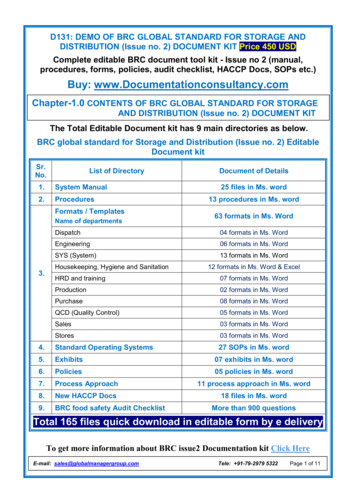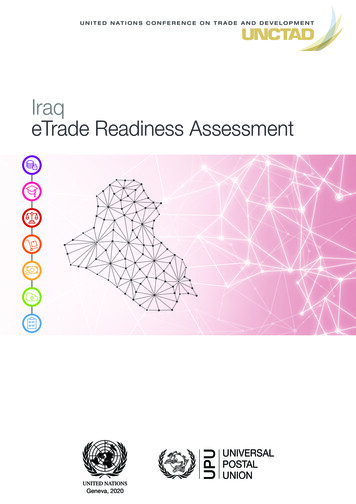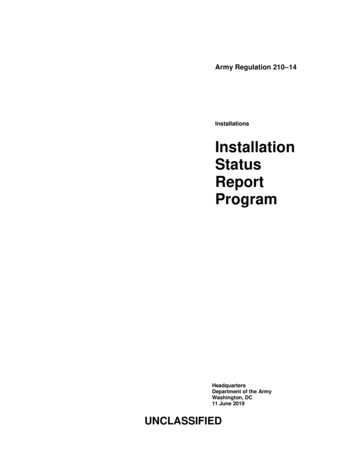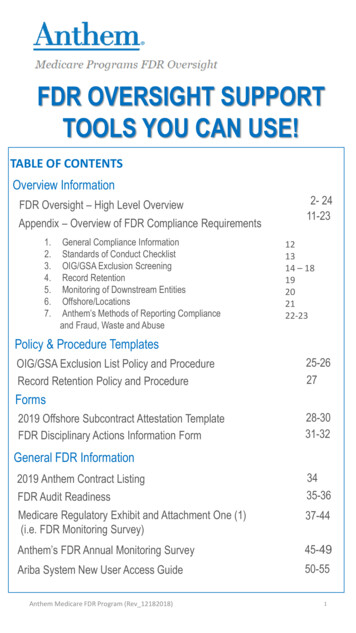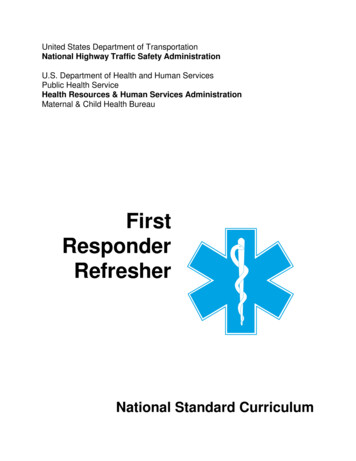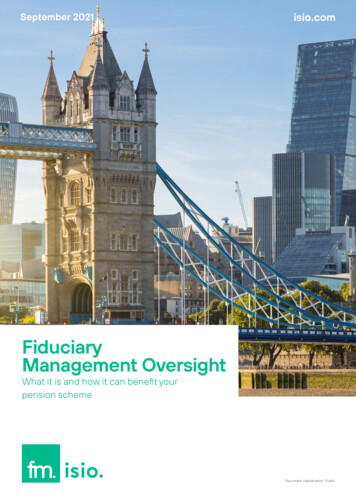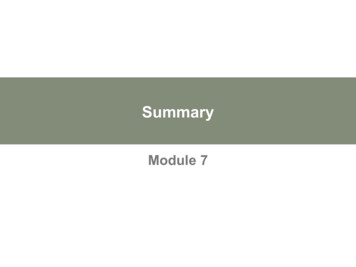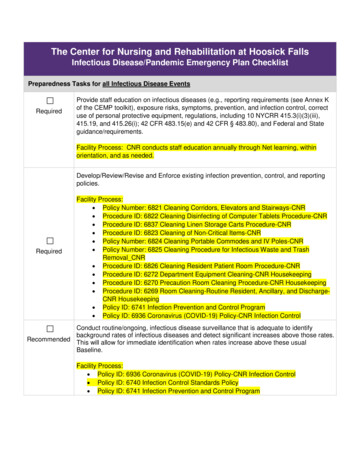
Transcription
U.S. DOT Federal Transit AdministrationTPM-20 Office of Capital Project ManagementProject Management OversightOversight Procedure 51–Readiness to Enter Engineering1.0PURPOSEThe purpose of this Oversight Procedure is to describe the review, analysis and recommendedprocedures and reporting requirements that the Federal Transit Administration (FTA) expects from theProject Management Oversight Contractor (PMOC) as regards the project’s readiness to enterEngineering.2.0BACKGROUNDA proposed project can be considered for advancement into Engineering only if the NEPA (NationalEnvironmental Policy Act) process has been completed; a New Starts submittal has been accepted byFTA and the project is rated favorably; approval to enter Project Development was received from FTAand the design has been developed to a level described within Appendix B of this OP; a project costestimate and detailed schedule have been developed to a level commensurate with the design; and theProject Sponsor can demonstrate adequate management capacity and capability to carry outEngineering (“design development”) for the proposed project, among other requirements. Allapplicable federal and FTA program requirements for Project Development and readiness to enterEngineering must have been satisfied.FTA's approval will be based on the results of its evaluation as described in 49 CFR Sections 611.9611.13 (Code of Federal Regulations, Title 49 – Transportation). The FTA Office of ProgramManagement (TPM) works closely with the Office of Planning and Environment (TPE) in determiningwhether a Project Sponsor is ready to enter Engineering. TPM, Office of Capital Project Management(TPM-20), has a critical role in determining technical readiness to enter Engineering as opposed toTPE’s role in evaluating whether environmental and planning requirements have been satisfied.Between Project Development and Engineering, the project is likely to be subject to an in-depth reviewfor management capacity and capability. Whether the Project Sponsor has the necessary managementapproach and organizational structure, internal and external controls, and other resources available toadminister a project is another important aspect of readiness to enter Engineering. The procedures formaking these assessments are established in the OP for Project Sponsor Management Capacity andCapability.Similarly, between Project Development and Engineering, project scope, schedule, and cost are subjectto intensive reviews as described in separate OPs. These reviews may culminate in a risk assessmentand the development of a risk and contingency management plan. The risk assessment identifies risk,assesses it, considers mitigations approaches, and develops a risk management plan to inform theProject Sponsor’s project management practices.OP 51 Readiness to Enter EngineeringSeptember 2015Page 1 of 4
3.0OBJECTIVESThe objective of this review is, based on the PMOC’s review of the Project Sponsor’s preliminarydesign documents, schedule, cost estimate, and other documents, to synthesize findings, and provideinput to FTA in the form of evaluations, conclusions, recommendations, and well-groundedprofessional opinions regarding the: Completeness, quality, and accuracy of the design, project schedule, and capital cost estimateat the conclusion of Project DevelopmentProject Sponsor’s program for advancing the design, schedule, and cost estimate to the pointof construction-ready bid documents for design-bid-build project delivery, or of preparingbridging documents for alternative delivery method contractsProject Sponsor’s ability to execute design and construction (i.e., management capacity andcapability) and whether the Project Sponsor has adopted a risk-based management approachto project implementation that incorporates findings of a project risk assessmentAdequacy of the Project Sponsor’s project controls and management policies and proceduresto execute the project, including those for maintaining quality control/quality assurance ofproducts and services; safety and security, construction and operation; and, acquisition ofrequired rights-of-way, among other policies and proceduresOverall readiness to advance to EngineeringThis information, combined with findings from environmental, New Starts, financial, and other FTAdirected reviews will support FTA’s determination regarding advancement of the Project Sponsor’sproject into the Engineering phase.4.0REFERENCESThe following are the principal, but by no means the only, references to Federal legislation,codification, regulation and guidance with which the PMOC should review and develop a solidunderstanding as related to the Project Sponsor’s project work being reviewed under this OP:4.1Legislative Surface Transportation and Uniform Relocation Assistance Act of 1987, P.L. 100-17 The Safe, Accountable, Flexible, Efficient Transportation Equity Act: A Legacy for Users, orSAFETEA-LU, Pub.L. 109-59 Moving Ahead for Progress in the 21st Century, or MAP-21, P.L. 112-1414.2United States Code 4.3FTA enabling statutes, 49 U.S.C. Chapter 53, ( See Section (e), and 49 USC 5309(e)(6) and5328(a)(3), Parts Sections 611.9-611.11)Regulations Project Management Oversight, 49 C.F.R. Part 633 Major Capital Investment Projects, 49 C.F.R. Part 611 Joint FTA/FHWA regulations, Metropolitan Planning, 23 C.F.R. Part 450OP 51 Readiness to Enter EngineeringSeptember 2015Page 2 of 4
Joint FTA/FHWA regulations, Environmental Impact and Related Procedures, 23 C.F.R. Part771U.S. DOT regulation, Uniform Relocation Assistance and Real Property Acquisition forFederal and Federally Assisted Programs, 49 C.F.R. Part 244.4FTA Circulars C4220.1F, Third Party Contracting Requirements C5010.1D, Grant Management Guidelines FTA Master Agreement C5800.1, Safety and Security Management Plan FTA Guidance on the Application of 49 U.S.C. 5324(c) – Railroad Right-of-Way Acquisition(April 30, 2009)5.0PROJECT SPONSOR’S SUBMITTALSIn advance of performing the review, the PMOC should obtain and study the project documentsidentified in Appendix B of this OP. The purpose of this checklist is to provide a categorized list ofelements that are expected to be complete prior to FTA’s approval for Entry to Engineering. Each listitem is followed by a brief description of the level of completion expected of that item. The PMOCshould notify FTA of important discrepancies in the project information that would hinder the review.An example would be a mismatch between drawings and cost estimate in which the drawings arecurrent and the cost estimate is two years old.6.0SCOPE OF WORKAppendix B provides detail of each relevant element to be assessed by the PMOC. For entry toEngineering, the Project Sponsor must have a suitable organizational structure in place to effectivelymanage the project. In addition, they must have made satisfactory progress in advancing the projectdesign and the corresponding cost estimate and schedule. At a minimum, the level of design detaildescribed in Appendix B of this OP must be provided in drawings. The supporting capital cost estimatemust be based on quantities of work established in the drawings and a substantial level of cost line itemdetail and backup for all other costs (vehicles, equipment, real estate, professional services, unallocatedand allocated contingencies, and financing costs). The master schedule should include sufficient detailto identify all significant activities, their durations, and logical ties to other activities, as described inAppendix B. In addition, it informs the PMOC as to the other information required of the ProjectSponsor to demonstrate technical readiness to enter Engineering.In general, for each work item listed in Appendix B, the PMOC will follow a similar analyticalapproach:1) Review and analyze the pertinent information available for completeness, adequacy,consistency, and appropriate level of detail given the phase of the work.2) Identify all apparent discrepancies and deficiencies.3) State findings in descending order of importance (most likely, largest consequences, leastlikely, moderate/minor consequences) and make recommendations for modifications orOP 51 Readiness to Enter EngineeringSeptember 2015Page 3 of 4
additional work by the Project Sponsor along with a time frame for the performance of thework.4) For major findings, provide recommendations for the Project Sponsor and/or FTA toimplement that will address the issue or correct or mitigate the deficiency.5) Identify action items, if any, and next steps.6) Document the assessment, including objectives, approach/methodology, findings, andrecommendations and provide back-up information in appendices or attachments to the mainbody of any report.It is important to note that the individual OPs describe the procedures for evaluating the reasonablenessand accuracy of each review element for the project. The PMOC shall incorporate the results of thesereviews into this assessment of Readiness to Enter Engineering.7.0REPORT, PRESENTATION, RECONCILIATIONThe PMOC shall provide FTA with a written report limited to 20 pages that summarizes its findings,analysis, recommendations, professional opinions, and a description of the review activitiesundertaken. Appendix C provides a sample Table of Contents. After FTA approval, the PMOCshould share the report with the Project Sponsor. In the event that differences of opinion exist betweenthe PMOC and the Project Sponsor regarding the PMOC’s findings, the FTA may direct the PMOC toreconcile with the Project Sponsor and provide FTA with a report addendum covering the agreedmodifications by the Project Sponsor and PMOC.The PMOC’s readiness report shall:1) Integrate the findings and recommendations of the reviews discussed in this OP.2) Include an executive summary in three pages or less that includes the following:a) Synthesis of findings on scope, schedule, and costb) Characterization of significant uncertainties in terms of likelihood (probable, remote,improbable) and their consequence (catastrophic, critical, serious, moderate, marginal)c) Professional opinion regarding the reliability of the project scope, schedule and cost andthe ability of the project sponsor to manage the projectd) Statement of potential range of cost (lower, upper bound and most likely)e) To reduce important uncertainties, recommendations for additional work of any kindincluding but not limited to investigation, planning or design work by the Project Sponsoror other party with a schedule for the performance of the work (recommend performanceeither before or after FTA’s decision regarding project advancement or funding).3) Document the assessment methodology.4) Provide back-up information in appendices.The report formatting requirements of OP 01 apply. When necessary, PMOC shall perform dataanalysis and develop data models that meet FTA requirements using Microsoft Office products such asExcel and Word and use FTA-templates when provided. The PMOC may add other software asrequired but documentation and report data shall be made available to FTA.OP 51 Readiness to Enter EngineeringSeptember 2015Page 4 of 4
APPENDIX AAcceptable Quality Level1DESIRED OUTCOMEPERFORMANCE REQUIREMENTThe PMOC shall reviewand analyze projectdocuments to determinethe completeness,quality and accuracy ofcost, schedule, budgetand design, and thereadiness of the projectto enter Engineering.R1a. The PMOC shall develop and document aprocess for review and analysis of the Project cost,schedule and design documents, Project Sponsor'sability to bring the Project to successful conclusion andthe readiness of the Project to enter Engineering.R1b. The PMOC shall use its process and projectmanagement judgment to review and analyze Projectdocuments to determine the completeness, quality andaccuracy of cost, schedule, budget and design, and thereadiness of the project to enter Engineering.The PMOC shall form aprofessional opinionand make findings andrecommendationsregarding the Project'sreadiness to enter theEngineering phase.R2a. The PMOC shall perform a review and analysisof the completeness, quality and accuracy of theengineering design, schedule and capital cost estimatefor the Project at the conclusion of ProjectDevelopment and make suitable findings andrecommendations.R2b. The PMOC shall, after review and analysis of theProject Sponsor's program for advancing the Project tothe point of construction-ready bid documents, provideits findings and recommendations.2R2c. The PMOC shall review and analyze ProjectSponsor's management system approach and ProjectSponsor's management capability and capacity toexecute Engineering and construction of the Project,and make suitable findings and recommendations.R2d.The PMOC shall determine whether the ProjectSponsor has in place necessary Project controls,management policies and procedures, including qualitycontrol/quality assurance, safety and security and rightof-way acquisition, and other necessary components toassure successful Project execution. The PMOC shallmake suitable findings and recommendations.CHECKLISTPERFORMANCE MEASUREACCEPTABLE QUALITY LEVELM1a. Review of the processdocumentation.Q1a. PMOC provides documentation ofthe process.M1b. Documented review and analysisof Project documents to determine thecompleteness, quality and accuracy ofcost, schedule, budget and design, andthe readiness of the project to enterEngineering.M2a. PMOC's review and opinion as tothe completeness, quality and accuracyof the Project cost, schedule andengineering documents at conclusion ofProject Development demonstratessound management and engineeringpractices and professional experience.M2b. PMOC's review and opinion as tothe suitability of Project Sponsor'sprogram demonstrates soundmanagement and engineering practicesand professional experience.M2c. PMOC's review, opinions and, ifnecessary, recommendations regardingmanagement approach andmanagement capability and capacitydemonstrates sound management andengineering practices and professionalexperience.M2d. PMOC's review, opinions and, ifnecessary, recommendations regardingProject Sponsor's management systemand Project procedures demonstratessound management and engineeringpractices and professional experienceQ1b. Review must be made and thePMOC provides internal verification thatthe process as documented has beenfollowed.Q2a. Professional opinion as to thecompleteness, quality and accuracy ofengineering design, cost and scheduledocuments at conclusion of ProjectDevelopment.Q2b. Professional opinion as to thesuitability of the Project Sponsor'sprogram for advancing the Project tothe point of construction-ready biddocuments.Q2c. Professional opinion andrecommendations where necessaryregarding the Project Sponsor'smanagement approach and technicalcapability and capacity to executeEngineering and construction of theProject.Q2d. Professional opinion andrecommendations where necessaryregarding Project Sponsor's projectcontrols, management system andProject procedures.MONITORINGMETHODMM1a. Periodicreview by FTAor its agent.MM1b. Periodicreview by FTAor its agent andthe PMOC'sinternalverification.MM2a. Periodicreview by FTAor its agent.MM2b. Periodicreview by FTAor its agent.MM2c. Periodicreview by FTAor its agent.MM2d Periodicreview by FTAor its agent.OP 51 Readiness to Enter EngineeringSeptember 2015Page A-1
DESIRED OUTCOME3The PMOC shallprovide FTA with awritten report of itsfindings, analysis,recommendations andprofessional opinions.PERFORMANCE REQUIREMENTR3. The PMOC shall present its findings, analysis,recommendations and professional opinions to FTA ina written report and, when so directed by FTA, seek toreconcile its findings with Project Sponsor to the extentpossible. A supplemental report shall be fileddescribing the results of reconciliation attempts.CHECKLISTPERFORMANCE MEASUREM3. Review of the PMOC'spresentation of findings, analysis,recommendations and professionalopinions by the FTA.ACCEPTABLE QUALITY LEVELQ3. Reports and presentations areprofessional, clear, concise, and wellwritten. The findings and conclusionshave been reconciled with other PMOCreports and have been reconciled withthe Project Sponsor to the extentpossible.MONITORINGMETHODMM3. Periodicreview by FTAor its agent.OP 51 Readiness to Enter EngineeringSeptember 2015Page A-2
APPENDIX BChecklist for Approval to Enter EngineeringThe purpose of this checklist is to provide a categorized list of elements to be completed, ideally, prior to FTA’s approval for Entry to Engineering. Each listed item isfollowed by a brief description of the level of completion expected of that item. The PMOC should note elements that need attention by the Project Sponsor andadjudge their significance to the overall project readiness to enter the engineering phase.Item1.01.11.1.1DescriptionPROJECT DEFINITIONSystem DefinitionAlignment DefinitionOPPMOC Review32CGeneral alignment is defined to include the approximate horizontal and vertical alignment,approximate station locations, and length. The alignment should be developed beyond thedefinition contained in the LPA to describe all structures necessary for the project. Minoralternative alignments may be evaluated within the corridor, as required, to the degree they arewithin the LPA definition.Configuration Management should document the process of managing the physical configurationsand their supporting processes through documents, records and data. Configuration Managementshould demonstrate a process that accommodates changes and continually documents how aphysical system is configured, ensuring that documents, records, and data remain concise and valid.Station design characteristics including station locations and station sizing. Should identifyplatform lengths and support spaces for mechanical/electrical equipment.1.1.2Configuration Management Plan1.1.3Station requirements32C1.21.2.1Environmental ConstraintsNEPA32B1.2.2Third party requirements2020NEPA requirements for entry into Engineering include preparation of an EIS where effects from aproposed project are significant or a Finding of No Significant Impact (FONSI) and accompanyingenvironmental assessment (EA) where effects are less than significant. For an EIS, FTA approvesthe preferred project through issuance of a Record of Decision (ROD). The ROD describes thescope of the projected and committed mitigations to reduce the effects of identified impacts.(1) Evaluate third-party agreement processes and current status of agreements. Where agreementsare not available, Project Sponsor should provide an outline or term sheet(s). When even thisinformation is not available, the needed agreement shall be identified and the issues and anyobstacles to executing the agreements noted.(2) Types of agreements and information to be reviewed include, but are not limited to: utility relocation agreements (public-water, sewer, etc.) intergovernmental agreements (IGA) with local & state and federal entities agreements with railroad companies (design, construction, operating) agreements with airport and port authorities third-party franchise agreements (gas, telephone, cable TV, other communications,OP 51 Readiness to Enter EngineeringSeptember 2015Page B-1
ItemDescription1.2.3Geotechnical Baseline2.0PROJECT MANAGEMENTPLANBasis of project documented2.1OP32C20PMOC Reviewpower); universities, colleges, other educational institutions agreements Private sector parties impacted, and public/private funding arrangements (including transitoriented development - TOD) Encroachment on Right of Ways (ROWs) Permits and/or waiver/exceptions Master permitting plan and schedule(3) The framework and content of these agreements must conform to the needs of the project.Agreements should be negotiated and completed to the extent possible prior to start ofEngineering Phase; where incomplete, a defined process for achieving completion is in place.Geotechnical baseline report prepared for projects involving tunnels or other undergroundstructures, or where specific structures (e.g., major bridges, retaining walls, levees, or otherfacilities) will be located on material with questionable or unknown load bearing capacity.Note: Some of the items listed are repeated below where additional review guidance is provided.(1) FTA’s regulations are found in 49 CFR 633.25, which requires a Project Management Plan tocontain at a minimum the following:(a) A description of adequate recipient staff organization, complete with well-defined reportingrelationships, statements of functional responsibilities, job descriptions, and job qualifications;(b) A budget covering the project management organization, appropriate consultants, propertyacquisition, utility relocation, systems demonstration staff, audits, and such miscellaneous costsas the recipient may be prepared to justify (Note: budget should also address design,construction, and start-up/commissioning);(c) A construction schedule (Note: schedule should address entire project from design throughrevenue operations);(d) A document control procedure and recordkeeping system;(e) A change order procedure which includes a documented, systematic approach to thehandling of construction change orders (Note: should also address change orders for allprocurements);(f) A description of organizational structures, management skills, and staffing levels requiredthroughout the construction phase (Note: budget should also address design, construction, andstart-up/commissioning);(g) Quality control and quality assurance programs which define functions, procedures, andresponsibilities for construction and for system installation and integration of systemcomponents (Note: QA/QC program should also address design, procurement, and startup/commissioning);(h) Material testing policies and procedures;(i) Plan for internal reporting requirements including cost and schedule control procedures; andOP 51 Readiness to Enter EngineeringSeptember 2015Page B-2
ItemDescriptionOP(2)(3)(4)(5)(6)(7)(8)PMOC Review(j) Criteria and procedures to be used for testing the operational system or its majorcomponents;”Legal authority for projectThe FTA or its PMOC may recommend a workshop be held to help establish roles andresponsibilities and define baseline standards of performance related to the management of theproject. Few, if any, Project Sponsors have all the capabilities or authorities to plan, design,and implement a major capital project by themselves. Bringing Project Sponsor staff,consultants, and relevant third parties together in a workshop early in the project life can helpto shape the project management approach. Through workshop discussions, all parties can gaina better understanding of each other’s requirements, responsibilities, and authorities as relatedto the project. The PMOC will review and summarize its findings and opinions and presentrecommendations with respect to the adequacy and soundness of the Project Sponsor’s plansand procedures, and the successful implementation of such plans and procedures for: NEPA coordination – The Project Sponsor’s plan for managing and implementingmitigation actions should be in place and environmental mitigation work should beincorporated into the design documents, cost estimates, and schedules. Design control. The Project Sponsor should implement appropriate plans and proceduresfor design control in all aspects. These plans and procedures should illustrate: consistency with design criteria; coordination and change control among design disciplines for drawings andspecifications; completeness of soils testing and site surveys; coordination with third parties; and completeness of project documents for bidding.The Project Management Plan should provide for implementation of project controls in allaspects including procedures for cost and schedule control, risk management, and dispute orconflict resolution during construction. The PMP should include procedures on cost sharing.Risk and contingency management policies and procedures should be in place and routinelyused.The PMP should confirm implementation of plans and procedures for project delivery andprocurement. Specifically, it should focus on the schedule for bidding construction packagesand procuring equipment and vehicles.Labor Relations and Policies should be in development.Development should be underway for plans and procedures regarding constructionadministration, construction management, construction inspection, coordinating constructionwork by third parties, site logistics, and construction change order and shop drawing documentflow and authorities.Development of Start-up and Revenue Operations should be underway to establish plans andprocedures regarding testing/commissioning, closeout of construction contracts, and training ofOP 51 Readiness to Enter EngineeringSeptember 2015Page B-3
ItemDescriptionOP2.2Environmental mitigation/assessment documented20PMOC Reviewstaff.(9) PMP Subplans should include the Quality Assurance / Quality Control Plan, Safety andSecurity Management Plan, Real Estate Acquisition Management Plan, and Bus and Rail FleetManagement Plans.(1) Description of Mitigation Principles2.3Design Procurement and ControlPlan20(2) Plan for Management and Implementation of Mitigation Actions(1) Design contracting plan for the Engineering Phase2.4Project Controls202.5Project construction delivery andprocurement plan202.6Labor relations and Policies20(2) Description of relationship between forecast ridership, operating plan and proposed projecttransit capacity in guideways, stations, support facilities(3) Design Criteria for each discipline(4) Schedule for the development of contract documents (level of development expected at eachmilestone for design/construction drawings, specifications, general and supplementaryconditions of contracts for construction, and the Division 1)(5) Plan / procedures for Design Drawings and Specifications(6) Procedures for Design Change and Configuration Control of documents during Design andConstruction(7) Plan (List and schedule) for third party agreements and permits including utilities, real estate,railroads, transit-oriented development/joint development, etc.(8) Investigation and Testing Plan (List and schedule) for site surveys, geotechnical and materialsinvestigation before/during design.(1) Document and Records Controls(2) Internal reporting procedures(3) Cost Control Procedures(4) Schedule Control Procedures(5) Risk Control Procedures(6) Dispute / Conflict Resolution Plan (claims avoidance and claims resolution)(1) Procedures for Procurement(2) Procurement Plan and Schedule(3) Contracting Strategy for Transit- Oriented Development and Joint Development, if applicable(4) Identification of Disadvantaged Business Enterprises (DBE) Opportunities, Federal DBE,State/Local WBE & MBE, Plans and Goals(5) Negotiating and Approving Change Orders and Claims(6) Procedures for claims avoidance(1) Wage Rates and Classifications(2) Wage and Hour RequirementsOP 51 Readiness to Enter EngineeringSeptember 2015Page B-4
Item2.7DescriptionConstruction Procedures forFixed InfrastructureOP20PMOC Review(3) State and Local Regulations(1) Construction Contract Administration(2)(3)(4)(5)2.8Start up and Revenue Operations202.9QA/QC Plan242.10Safety and Security ManagementPlan222.11Real estate Acquisition andRelocation Plan232.12Rail and Bus Fleet Management372.13Before and After StudyDocumentationMANAGEMENT CAPACITYAND CAPABILITYOrganizational charts273.03.121Construction ManagementConstruction InspectionCoordination with Third PartiesSite Logistics Plan (materials transport and storage; temporary site facilities; maintenance ofexisting pedestrian ways, transit and traffic operations during construction; protection ofexisting utilities)(6) Processing Shop Drawings, Bulletins, and RFIs(7) Substantial Completion; Final Completion(1) Testing plan elements are identified and would be expanded at a later date(2) Closeout materials (warranties, testing results, O&M manuals, spare parts, etc.) to be identifiedto provide direction to the Engineer(3) Plan for Training of Staff to be developed laterAt entry to Engineering, the QAP shall fully address all elements governing project activitiesthrough the design phase. It should also contain, at least in outline form and to the level of detailpossible, information relative to the upcoming construction phase. The PMOC shall also confirmthat the Project Sponsor has exhibited both a Quality Assurance and Quality Control review of itsPD package.In place and is in compliance with FTA guidance as provided in Circular C5800.1. PreliminaryHazard Analysis (PHA) and Threat and Vulnerability Assessment (TVA) are complete. Safety andSecurity Design Criteria development is underway.(1) Conforms with and is expressly incorporated within the Design Drawings, Master Scheduleand budget for all phases and types of work planned or anticipated. Further, the RAMP mustmeet all federal requirements. The Project Sponsor is to provide a complete list of all parcelswith title searches on all properties to be acquired and RAMP procedures.(2) Preparation of a relocation plan to include interviews with potential displacees which stressesthat displacees are not to move until project plans have been finalized.(3) Project Sponsor shall exhibit management capacity and capabilities to implement the real estateacquisition and relocation process, including organization structure and staffing plan and anyconsultant agreements undertaken in support of these activities.Plan demonstrates consistency with the project scope, NEPA documents, and the project’sOperations Plan.Plan submitted in accordance with FTA guidance; verify that the plan has preserved the projectscope and capital cost information.Project organization charts show the complete organization, covering all project functions and allOP 51 Readiness to Enter EngineeringSeptember 2015Page B-5
ItemDesc
Engineering ("design development") for the proposed project, among other requirements. All applicable federal and FTA program requirements for Project Development and readiness to enter Engineering must have been satisfied. FTA's approval will be based on the results of its evaluation as described in 49 CFR Sections 611.9-
